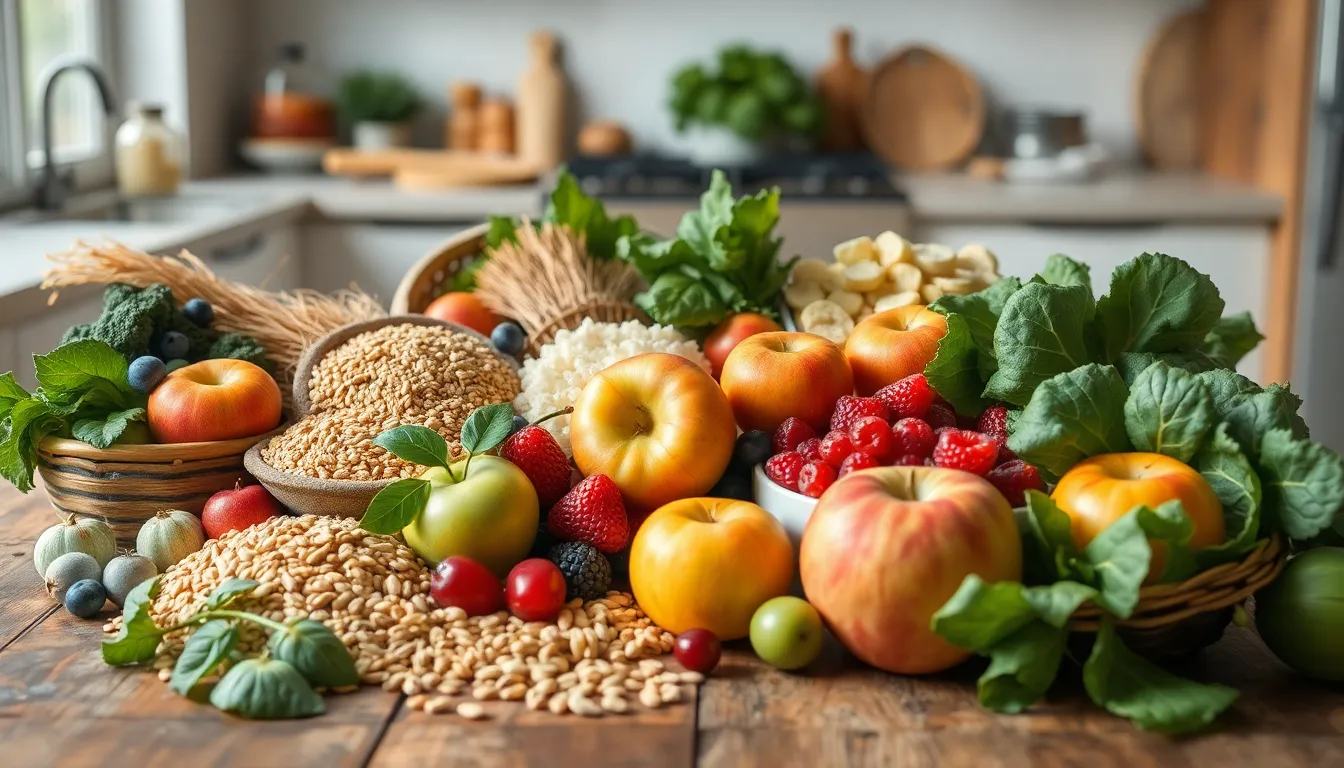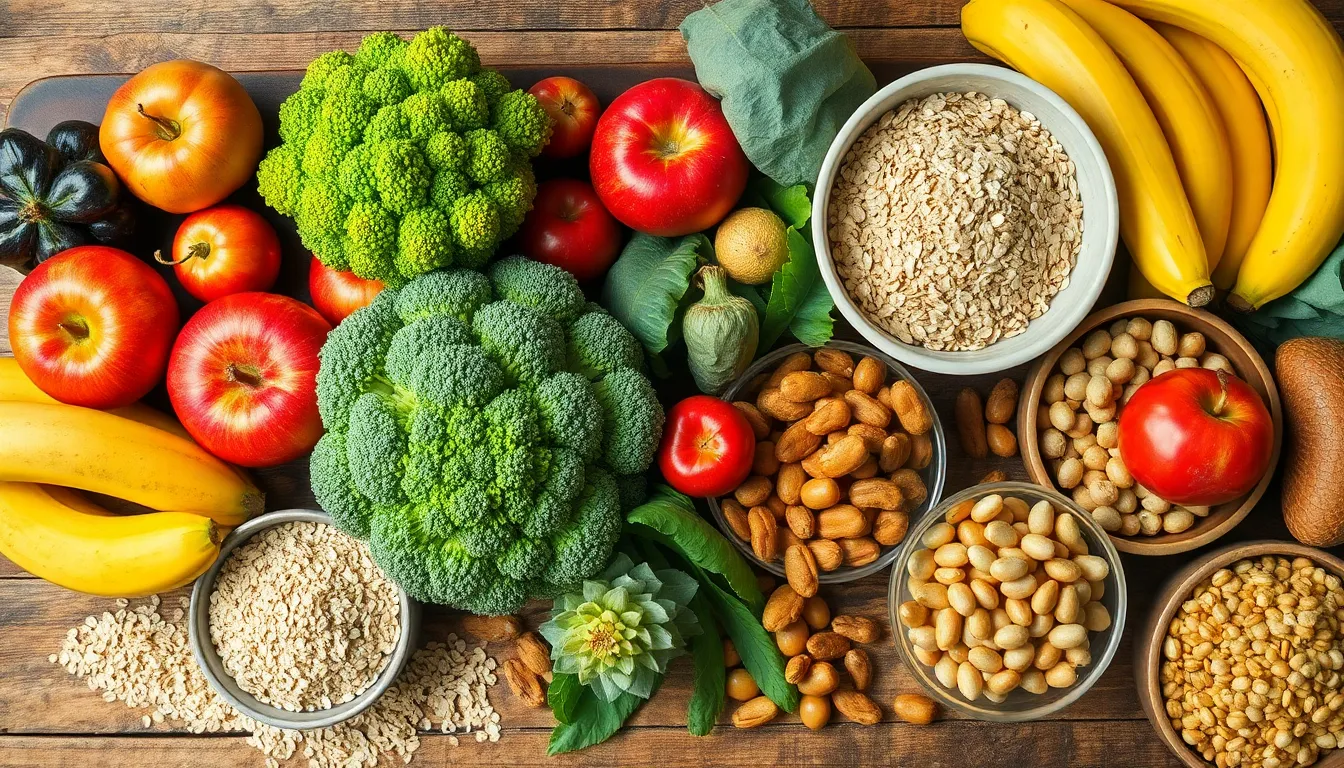In a world where fast food reigns supreme and snacks are often more about convenience than nutrition, fiber-rich foods are the unsung heroes of a healthy diet. These little powerhouses not only keep your digestive system humming along but also help you feel fuller for longer. Who knew that munching on beans and broccoli could be the secret weapon in your quest for a healthier lifestyle?
Table of Contents
ToggleUnderstanding Fiber-Rich Foods
Fiber-rich foods play a vital role in a balanced diet. They support digestion and create a feeling of fullness, which can aid in maintaining a healthy weight.
What Are Fiber-Rich Foods?
Fiber-rich foods contain high levels of dietary fiber. Common examples include fruits, vegetables, whole grains, legumes, nuts, and seeds. These foods contribute to overall health by promoting bowel regularity and lowering the risk of chronic diseases. They encourage beneficial gut bacteria and help control blood sugar levels. Incorporating these foods into daily meals can significantly enhance nutritional intake.
Types of Dietary Fiber
Two main types of dietary fiber exist: soluble and insoluble. Soluble fiber dissolves in water and helps lower cholesterol and blood sugar levels. Sources include oats, beans, and apples. Insoluble fiber, on the other hand, does not dissolve in water and promotes bowel health. Whole grains, nuts, and many vegetables provide this type of fiber. Including a variety of both types in the diet supports digestive health and overall well-being.
Health Benefits of Fiber-Rich Foods

Fiber-rich foods offer significant health benefits that contribute to overall well-being. These foods enhance digestive health, support weight management, and promote heart health.
Digestive Health
Incorporating fiber-rich foods into the diet supports digestive health by promoting regular bowel movements and preventing constipation. A daily intake of 25 grams for women and 38 grams for men helps maintain bowel regularity. Soluble fiber, found in oats and apples, aids in softening stool, while insoluble fiber from whole grains and vegetables adds bulk. Including both types leads to a well-rounded digestive system. Increased fiber consumption reduces the risk of developing gastrointestinal disorders, such as diverticulosis.
Weight Management
Fiber-rich foods contribute to weight management by increasing satiety. Consuming fiber leads to feeling full longer, which helps control portion sizes at meals. Foods like beans, lentils, and vegetables provide volume without excessive calories. Research shows that increased fiber intake correlates with lower body weight and reduced obesity risk. Prioritizing high-fiber snacks, such as fruits and nuts, can replace calorie-dense options, fostering healthier eating habits.
Heart Health
Fiber plays a crucial role in heart health by reducing cholesterol levels and improving blood pressure. Soluble fiber effectively lowers LDL cholesterol, leading to a decreased risk of heart disease. Foods like oats, beans, and fruits are beneficial in this regard. Studies indicate that a high-fiber diet lowers the chances of cardiovascular events, such as heart attacks and strokes. Fiber-rich foods also support healthy weight, another key factor in heart disease prevention.
Top Fiber-Rich Foods to Include in Your Diet
Incorporating fiber-rich foods into meals enhances digestive health and provides essential nutrients. Many options available deliver substantial fiber content.
Fruits
Fruits are excellent sources of dietary fiber, offering both soluble and insoluble types. Apples, bananas, and pears contain pectin, a type of soluble fiber that assists in lowering cholesterol. Berries like raspberries and blackberries provide high fiber per serving, promoting satiety. Oranges and avocados contain additional benefits, including vitamins and healthy fats. Consuming a variety of these fruits throughout the day ensures a sufficient intake of fiber.
Vegetables
Vegetables contribute significant fiber, particularly in the form of insoluble fiber. Broccoli, carrots, and Brussels sprouts promote digestive regularity while delivering vitamins and minerals. Leafy greens, such as spinach and kale, also add fiber alongside antioxidants. Cauliflower and artichokes stand out with notably high fiber content. Regularly consuming different vegetables aids in meeting daily fiber goals and supports overall health.
Whole Grains
Whole grains include essential fiber, along with numerous other nutrients. Oats, quinoa, and brown rice provide soluble fiber, which helps control blood sugar levels. Barley and whole wheat products, like bread and pasta, add bulk to meals. Choosing whole grain options instead of refined grains enhances satiety and digestive health. Incorporating a variety of whole grains into the diet ensures diverse sources of fiber.
Legumes and Nuts
Legumes and nuts represent an incredible source of fiber and protein. Lentils, chickpeas, and black beans provide substantial amounts of both soluble and insoluble fiber. Edamame and split peas are also excellent choices for a fiber boost. Nuts like almonds, walnuts, and pistachios not only supply fiber but also healthy fats. Adding these foods to daily meals promotes fullness and enhances nutritional quality.
Tips for Incorporating More Fiber-Rich Foods
Incorporating fiber-rich foods into the daily diet enhances health significantly. These tips help achieve higher fiber intake efficiently.
Gradual Increase of Fiber Intake
Start by gradually increasing fiber intake to avoid digestive discomfort. Introducing fiber-rich foods slowly helps the digestive system adjust. Aim for an additional 5 grams weekly until reaching the recommended daily intake of 25 grams for women and 38 grams for men. Adding small portions of beans, whole grains, or fruits can ease this transition. Hydrating adequately supports this adjustment, as water complements increased fiber consumption.
Meal Planning and Preparation
Meal planning can simplify the inclusion of fiber-rich foods in meals. Creating a weekly menu that features a variety of fruits, vegetables, and whole grains ensures balanced nutrition. Preparing snacks ahead of time, like trail mix with nuts and seeds, makes healthy choices more accessible. Cooking large batches of fiber-rich dishes, such as lentil soup or vegetable stir-fry, promotes convenience throughout the week. Using whole grain options for breakfasts and lunches enhances fiber intake effortlessly.
Embracing fiber-rich foods can significantly enhance overall health and well-being. By making simple dietary adjustments and incorporating a variety of fruits vegetables whole grains legumes and nuts individuals can enjoy the numerous benefits that fiber offers. From improved digestive health to better weight management and heart health these foods play a vital role in maintaining a balanced diet.
With practical tips for increasing fiber intake gradually and making meal planning easier anyone can transform their eating habits. Prioritizing fiber not only supports bodily functions but also fosters a healthier lifestyle. It’s time to make fiber-rich foods a staple in everyday meals for lasting health benefits.



